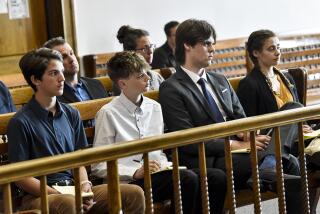Prairie schools find a lifeline, but the state wants to share the wealth
- Share via
A funny thing happened on the relentless road to ruin the hardy homesteaders of eastern Montana have traveled for the better part of the last century: Things started looking up.
Not only has there been rain the last few years in a land usually so empty and dusty you can barely coax wheat out of it; but with a massive bed of oil-laced rock deep under the border of Montana and North Dakota, and with new technology finally able to plumb it, suddenly there are drilling rigs and construction trucks rumbling in on highways heretofore traveled mainly by broken farmers headed for the exits.
Nowhere has the bonanza been more apparent than in the small prairie schools that have sprung up over the decades alongside the grain elevators, volunteer fire stations and Rexall drug stores. From Sidney on the North Dakota border in the north to here in Baker, 3½ hours east of Billings, the rural school districts atop the fabled Bakken formation and Cedar Creek Anticline are awash in cash.
Baker, a town of 1,700 with 401 students in its three aging schools, has $43.5 million in the bank, more than 13 times its entire annual operating budget. The district is breaking ground on an $8.4-million expansion and renovation that will mean a new gym, classrooms and band room.
In Sidney, where enrollment has nearly doubled over the last several years (15 new students showed up in the last six weeks alone), the schools just put in a new paneled library so big the students call it “Barnes & Noble.” Lambert, with just 90 students, has more than $10 million in the bank.
With school districts elsewhere in Montana struggling to stay afloat, the idea of so much money tucked away across a landscape that still has more cows than people was inevitably going to seem outrageous, and from there, it’s only a short drive to irresistible. At the head of the raiding party that struck this spring was Gov. Brian Schweitzer.
The Democratic governor, who already is presiding over a surplus of up to $300 million and hopes to turn eastern Montana’s oilfields into the nation’s most important energy supply, announced early this year he was going to push rural eastern school districts to share the attendant wealth.
“It’s a killer,” said Bill Colter, superintendent of Lambert Public Schools. “We were just targeted.”
Now, if the district earns an additional $6.8 million in oil production tax revenue, $5.5 million of it will have to go to the state.
In Plevna, little more than a grain elevator and a post office, the school will give the state an estimated $67,000 a year out of $2.2 million earned in oil money.
“Our school is the center of our community. It is our community,” said Supt. Jule Walker, who taught for 10 years in Long Beach before moving back to her home in eastern Montana.
In Baker, School Supt. Don Schillinger is pushing for a long-term formula for funding that won’t leave schools at the mercy of fickle economies. The town sits on the edge of the Cedar Creek Anticline, where petroleum was discovered early in the 20th century, and has already has seen oil booms come and go. Schillinger says people in eastern Montana know that when it’s good, it never lasts long.
“Three years from now, we may have nothing at all. You’ve got to make sure that when we don’t have oil and gas money anymore, are we still going to be able to survive?”
The governor asserts that eastern Montana taxpayers have been paying lower taxes for schools than other parts of the state — some districts, such as Baker and Plevna, levy no local taxes at all.
Meanwhile, he said, schools in western Montana have shared timber revenues with the rest of the state; in Butte, mining money got put into a pot to share. Why, he asked, do schools in eastern Montana think they can just put their money in the bank?
“The problem is not that the oil and gas money isn’t distributed to all of the districts in Montana. It’s that some of these districts have been gaming the system,” Schweitzer said in an interview.
“Fair is fair,” he said. “This just means they’re going to be paying a portion of their local education cost the way everybody else in Montana does.”
Schools will be allowed to keep about 130% of their normal budgets and put substantial sums in reserves. But eastern schools say they face higher costs because of their remote locations, and they now face skyrocketing costs for housing and competition for workers.
“I had an elementary school teacher who was from here; I lost him to an oil company. Just an awesome young man. But they know potential when they see it, and they can make a lot more money,” said Walker. “And not everyone wants to come to Plevna, Mont., to live.”
More to Read
Sign up for Essential California
The most important California stories and recommendations in your inbox every morning.
You may occasionally receive promotional content from the Los Angeles Times.










